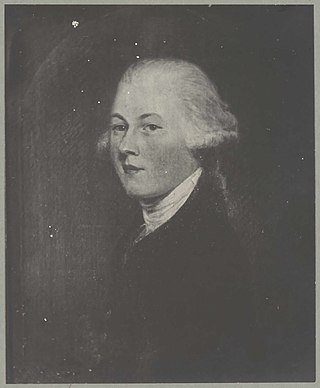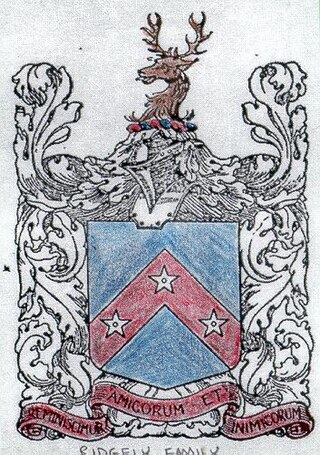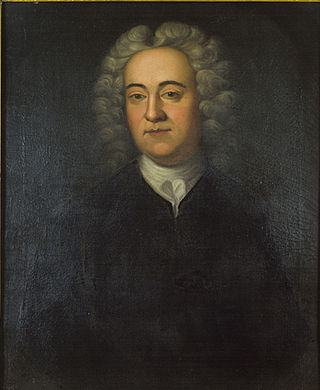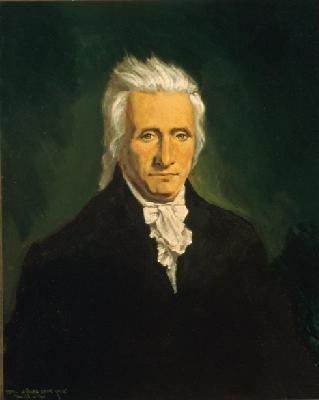Jacob Henderson was an Irish clergyman and philologist who emigrated to the colonial Provinces of Pennsylvania, then Maryland, where he became a prominent land owner and church leader.
Very little is known about Henderson before 1710. On June 5, 1710, he was admitted to the Holy Orders by the Bishop of London, Henry Compton and appointed to the Mission at Dover then part of the Province of Pennsylvania and known as Dover Hundred. [1]
In 1711, he traveled to New York and was apparently disturbed by what he observed in the churches there. In June 1712, he returned to England and described the state of the Church of England in New York and New Jersey as unacceptable, and implicating Governor Robert Hunter. While Hunter wrote a written rebuttal to this assessment, it served to raise Henderson's stature. [1]
In December 1712, Henderson returned to the new world after being appointed to a Mission at Patuxent Hundreds (without a parish).
Jacob Henrderson's first wife Mary (surname unknown) was the third and final wife of Mareen Duvall who died in 1694 and she administered his substantial estate. [2] [3] [4] Duvall had purchased sizeable tracts of land, including Catton, later known as Belair as well as owning Middle Plantation in Davidsonville, Maryland. [5] : 1–9
In 1696, she married Henry Ridgely. [6] [7] In 1700, Ridgely purchased an additional 100 acres (0.40 km2) adjacent to Catton called Enfield Chase. Upon Ridgely's death in 1710, his third wife, now twice widowed, [3] [8] was executrix of the will and received those properties. [9] Mary had previously inherited Middle Plantation in Davidsonville, Maryland when her first husband, Mareen Duvall died in 1694. [4] [5]
Mary married Henderson in 1713, quickly establishing the man as a wealthy landowner. [1]
In 1713, St. Anne's Parish in Annapolis, Maryland had become vacant and Henderson was asked to serve there as well, despite living about 20 miles (32 km) away. He served there for a year. [1]
That same year, he and his wife built a small chapel near their residence at Belair, which was known as Henderson's Chapel or Forest Chapel. [1] [5] : 4–9
It is not clear if Rev. Johnathan White died in 1717 or was removed from the position as Rector of Queen Anne Parish. [1] On December 17, 1717, Reverend Jacob Henderson was appointed as rector of Queen Anne Parish. [3]
In 1723, the Bishop of London, Dr. John Robinson died, and his successor, Dr. Edmund Gibson chose not to renew Henderson's appointment to the Mission. Henderson then focused exclusively on the Parish. [1]
In 1729, Henderson traveled to England for 18 months to discuss the difficulties he found in the Colonies. When he returned, he had been appointed to the overall Mission of the Colony. The clergy welcomed his return, but the Laity were bitterly opposed. [1]
He then convened the Conventions of the Clergy on both the western and eastern shores of the Province. Over the next several years, he focused on the issue of discipline and profligacy among the clergy. This met with a great deal of resistance and by 1734, he resigned his appointment, being the last representative of the Bishop in the Colony. [1]
On 19 January 1735/6, Henderson's wife Mary was buried, her death date being unknown. She was buried in Henderson's Chapel. [1] In 1737, Henderson gave the chapel and 4 acres (16,000 m2) of land for the use of Queen Anne's Parish called "the Glebe whereon there is a Chapple now standing." Almost 100 years later, in 1836 Henderson's Chapel became an independent congregation, Holy Trinity Episcopal Church. [1] [5] [10]
After the death of his first wife Mary, Jacob Henderson secondly married Mary (Stanton) on 2 November 1740. who at the time was the widow of Robert Tyler. [11] She was the widow successively of a Mr. Dodd and of Robert Tyler, whom she had married on 12 June 1718 as Mary [the widow] Dodd. [12]
By this time, Henderson had become good friends with Provincial Governor Samuel Ogle. [1] On March 30, 1737, for the sum of £500, Henderson sold three parcels of land to Ogle for him to build his Governor's estate. [5]
On July 6, 1737, Ogle granted Henderson leave of absence from the Province for 18 months to return to England. During this leave, Henderson was elected to the Society for the Propagation of the Gospel and returned to Maryland in May 1739. Nine years later, in August 1748, Ogle granted Henderson another leave of 18 months for England. Henderson returned for the final time in April 1750. [1]
Henderson died on August 27, 1751, after 34 years of service at St. Barnabas and Queen Anne. After specific bequests to family members and friends, he bequeathed the residue to the Society for the Propagation of the Gospel. [1] [13] The inventory of his estate was valued at 1423 pounds, 8 shillings, 8 pence. An additional inventory added another 41 pounds, 10 shillings, 9 pence. [14] The distribution to the Society for the Propagation of the Gospel was made in two payments. One was for 62 pounds, 17 shillings, 5 pence. The second was for 43 pounds, 4 shillings, and 10 pence. [15] His will had been written on 4 August 1751 and probated on 26 October 1751. [13] His wife Mary (née Stanton) wrote her will on 2 October 1761 and was probated on 18 February 1762 in Prince George's County, Maryland. In her will she styled herself as "widow of The Rivirend Mr. Jacob Henderson, late of Prince George's Co. decd." Among her bequests were ones to her "son-in-law" [step-son] Robert Tyler and to Daniel Stanton, son of my brother Daniel Stanton (my sd. nephew lately living in Philadelphia). [16]

Charles Calvert, 5th Baron Baltimore, was a British nobleman and Proprietary Governor of the Province of Maryland. He inherited the title to Maryland aged just fifteen, on the death of his father and grandfather, when the colony was restored by the British monarchy to the Calvert family's control, following its seizure in 1688. In 1721 Charles came of age and assumed personal control of Maryland, travelling there briefly in 1732. For most of his life, he remained in England, where he pursued an active career in politics, rising to become Lord of the Admiralty from 1742 to 1744. He died in 1751 in England, aged 52.
Benjamin Tasker Sr. was the 21st Proprietary Governor of Maryland from 1752 to 1753. He also occupied a number of other significant colonial offices, including, on various occasions, being elected Mayor of Annapolis.

Colonel Benjamin Tasker Jr. was a politician and slave trader in colonial Maryland, and Mayor of Annapolis from 1754 to 1755. He was the son of Benjamin Tasker Sr., Provincial Governor of Maryland from 1752 to 1753.

Benjamin Ogle was the ninth Governor of Maryland from 1798 to 1801.

Samuel Ogle was the 16th, 18th and 20th Proprietary Governor of Maryland from 1731 to 1732, 1733 to 1742, and 1746/1747 to 1752.
Edward Digges was an English barrister and colonist who became a premium tobacco planter and official in the Virginia colony. The son of the English politician Dudley Digges represented the colony before the Virginia Company of London and the royal government, as well as served for two decades on the colony's Council of State. Digges served as interim Colonial Governor of Virginia from March 1655 to December 1656, and for longer periods as the colony's receiver general and auditor-general. He is also known for planting mulberry trees and promoting the silk industry in the colony.
The Gazette, founded in 1727 as The Maryland Gazette, is one of the oldest newspapers in America. Its modern-day descendant, The Capital, was acquired by The Baltimore Sun Media Group in 2014. Previously, it was owned by the Capital Gazette Communications group, which published The Capital, Bowie Blade-News, Crofton-West County Gazette, and Capital Style Magazine.
Thomas Bladen was a colonial governor in North America and politician who sat in the British House of Commons between 1727 and 1741. He served as the 19th Proprietary Governor of Maryland from 1742 to 1747.

Col. Charles Ridgely II, "Charles The Merchant" (1702–1772), of "Ridgely's Whim", was a Justice, planter, merchant, ironmaster, and member of the General Assembly of Maryland's lower chamber, House of Delegates and one of Baltimore County's commissioners. Charles II was the son of Charles Ridgely I,, , and Deborah Dorsey, daughter of Hon. John Dorsey.

The Belair Mansion, located in the historic Collington area and in Bowie, Maryland, United States, built c. 1745, is the Georgian style plantation house of Provincial Governor of Maryland, Samuel Ogle. Later home to another Maryland governor, the mansion is listed on the National Register of Historic Places.

Benedict Leonard Calvert was the 15th Proprietary Governor of Maryland from 1727 through 1731, appointed by his older brother, Charles Calvert, 5th Baron Baltimore (1699–1751). He was named after his father, Benedict Calvert, 4th Baron Baltimore (1679–1715). Calvert had tuberculosis and died from it on board the family ship, The Charles, on 1 June 1732, while returning to his home in England, aged 31.

St. Barnabas Church, also known as St. Barnabas' Episcopal Church, Leeland, was built in Leeland, Maryland, and was established in 1704 as the parish church of Queen Anne Parish which had been established that same year. Because of its location in one of the richest tobacco-producing regions in Colonial Maryland, the small church has been a cultural hub for southern Maryland from early colonial times, through the American Revolution, Civil War, and Reconstruction. The church holds some highly significant art and was the scene of a fiery anti-revolutionary showdown that was close to erupting in violence.

Holy Trinity Episcopal Church in Collington, Maryland is a historic place of worship dating back more than three centuries. Originally a chapel of ease for Queen Anne Parish, it became a separate parish in 1844.

Mareen Duvall (1625–1694) was a French Huguenot and an early American settler.

James Thomas Woodward was an American banker and owner of a major thoroughbred horse dynasty.

Daniel Dulany the Elder (1685–1753) was a lawyer and land-developer in colonial Maryland, who held a number of colonial offices. In 1722 Dulany wrote a pamphlet entitled The Right of the Inhabitants of Maryland, to the Benefit of the English Laws, asserting the rights of Marylanders over the Proprietary Government.

Rosaryville State Park is a public recreation area with historical features located three miles southeast of Joint Base Andrews in Rosaryville, Prince George's County, Maryland. The state park includes the restored Mount Airy Mansion, which was formerly operated as an event facility, as well as hiking, biking and equestrian trails for day-use.

Gabriel Duvall was an American politician and jurist. Duvall was an Associate Justice of the Supreme Court of the United States from 1811 to 1835, during the Marshall Court. Previously, Duvall was the Comptroller of the Treasury, a Maryland state court judge, a member of the U.S. House of Representatives from Maryland, and a Maryland state legislator.
The Duvall Farm was a historic farm located in North Laurel, Howard County, Maryland, now the site of Coastal Sunbelt Produce.
Charity Folks was an African-American woman who lived in Annapolis, Maryland, both as a slave and a free woman.